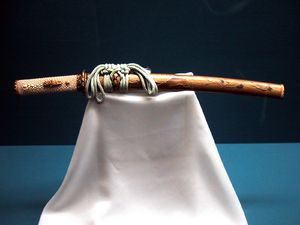Wakizashi
The wakizashi (Kanji: 脇差 Hiragana: わきざし) (meaning "side insertion") is a traditional Japanese sword with a shōtō blade between 30 and 60 centimetres (12 and 24 in), with an average of 50 cm (20 in). It is similar to but shorter than a katana, and usually shorter than the kodachi ("small sword"). The wakizashi was usually worn together with the katana by the samurai or swordsmen of feudal Japan. When worn together the pair of swords were called daishō, which translates literally as "large and small". The katana was often called the sword or the long sword and the wakizashi the companion sword.[1][2]
Contents |
Brief history

References to wakizashi use date at least back to the sixteenth century. Originally, the term wakizashi was used to mean any sword worn on the side of the main sword. Later, the term was used to denote the group of swords which were shorter than the main sword of the samurai, and as a result, wakizashi acquired the meaning of the side sword, because a side sword was shorter than the main sword by its nature.
The samurai used to wear different types of side swords or daggers; for example, chiisa-gatana or yoroi-doshi, and the term "wakizashi" did not mean any official blade length. The first usage of a wakizashi dates back to the period between 1332 and 1369. For example, Oda Nobunaga (織田 信長, 1534–1582) wore a daishō pair of uchigatana: a katana with a wakizashi. This reflects the common practice of wearing a wakizashi as the side sword of a katana.
After the Muromachi period, the rulers of Japan tried to regulate the types of swords and the social groups which were allowed to wear them. This was to enhance the reputation, power and the class of the samurai class, who were the only social class permitted to carry the daishō. In the late Momoyama period the government passed laws which categorized the swords in accordance to their blade length. Nevertheless, there were people who openly disobeyed the laws and carried long wakizashi (ōwakizashi), which had approximately the same length as the katana. This was caused by the confusing definition of katana, wakizashi, and tantō of those times, and some townsmen and members of yakuza gangs carried such swords.
Use
The wakizashi were used as backup weapons and as tools to decapitate defeated enemies, and sometimes to commit ritual suicide. The master swordsman Miyamoto Musashi (宮本 武蔵, 1584–1645) was known to have wielded a katana and a wakizashi in respective hands in order to fight with two weapons simultaneously for maximum combat advantage.
See also
- Aikuchi
- Kodachi
- Tantō
- List of daggers
- Types of swords
Notes
- ↑ Mol, Serge (2003). Classical weaponry of Japan: special weapons and tactics of the martial arts. Kodansha International. pp. 18–24. ISBN 4-7700-2941-1. http://books.google.com/books?id=ZzIXkFec0e8C&pg=PA18&dq=wakizashi#v=onepage&q=wakizashi&f=false.
- ↑ Ratti; Westbrook, Adele (1973). Secrets of the samurai: a survey of the martial arts of feudal Japan. Tutle Publishing. p. 258. ISBN 0-8048-1684-0. http://books.google.com/books?id=ZFf9e0DmHZUC&pg=PA258&dq=wakizashi#v=onepage&q=wakizashi&f=false.
References
- Takeuchi, Dr. S. Alexander (aka Dr. T). "Dr. T's "Nihonto Random Thoughts" Page". Florence, Alabama: Department of Sociology, University of North Alabama. http://www.una.edu/faculty/takeuchi/DrT_Jpn_Culture_files/Nihon_to.htm.
External links
|
|||||||||||||||||